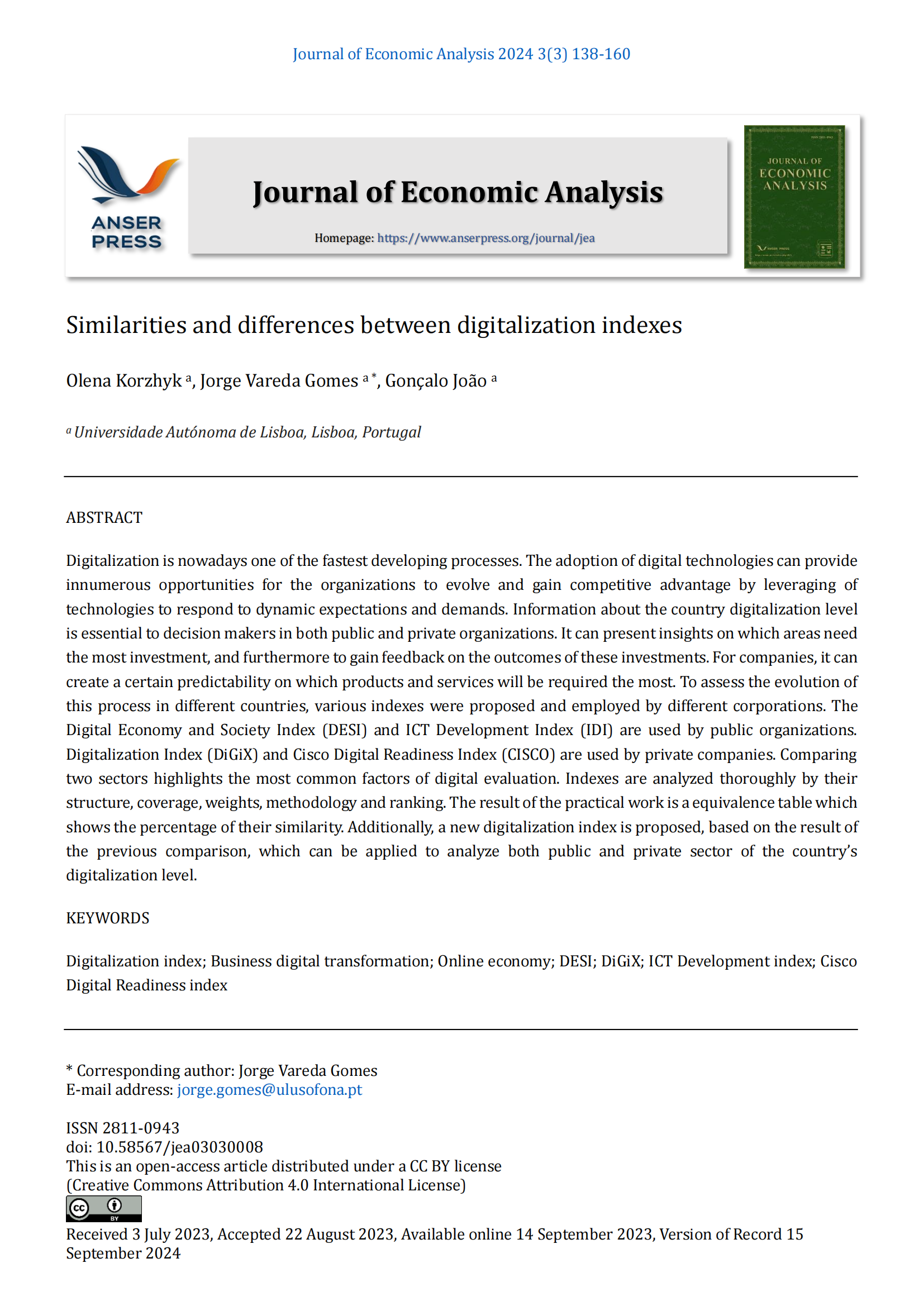Similarities and differences between digitalization indexes
DOI:
https://doi.org/10.58567/jea03030008Keywords:
Digitalization index; Business digital transformation; Online economy; DESI; DiGiX; ICT Development index; Cisco Digital Readiness indexAbstract
Digitalization is nowadays one of the fastest developing processes. The adoption of digital technologies can provide innumerous opportunities for the organizations to evolve and gain competitive advantage by leveraging of technologies to respond to dynamic expectations and demands. Information about the country digitalization level is essential to decision makers in both public and private organizations. It can present insights on which areas need the most investment, and furthermore to gain feedback on the outcomes of these investments. For companies, it can create a certain predictability on which products and services will be required the most. To assess the evolution of this process in different countries, various indexes were proposed and employed by different corporations. The Digital Economy and Society Index (DESI) and ICT Development Index (IDI) are used by public organizations. Digitalization Index (DiGiX) and Cisco Digital Readiness Index (CISCO) are used by private companies. Comparing two sectors highlights the most common factors of digital evaluation. Indexes are analyzed thoroughly by their structure, coverage, weights, methodology and ranking. The result of the practical work is a equivalence table which shows the percentage of their similarity. Additionally, a new digitalization index is proposed, based on the result of the previous comparison, which can be applied to analyze both public and private sector of the country’s digitalization level.
References
Belman, Dale and Paul J. Wolfson (2014). What Does the Minimum Wage Do? UpJohn Institute for Employment Research, Kalamazoo, Michigan. https://doi.org/10.17848/9780880994583
Card, David and Alan B. Kruegar (1994). Minimum Wages and Employment: A Case Study of the Fast-Food Industry in New Jersey and Pennsylvania. American Economic Review 84(4): 772-793. https://doi.org/10.3386/w4509
Chletsos, Michael and Georgios P. Giotis (2015). The Employment Effect of Minimum Wage using 77 International Studies since 1992: A meta-analysis. MPRA Paper 61321, University of Munich.
Doucouliagos, Hristos and T.D. Stanley (2009). Publication Selection Bias in Minimum-Wage Research? A Meta-Regression Analysis. British Journal of Industrial Relations 47(2): 406-428. https://doi.org/10.1111/j.1467-8543.2009.00723.x
Dube, Arindrajit E., T. William Lester, and Michael Reich (2010). Minimum Wage Effects Across State Borders: Estimates Using Contiguous Counties. The Review of Economics and Statistics 92 (4): 945–964. https://doi.org/10.1162/REST_a_00039
Even, William and David Macpherson (2019). Where Does the Minimum Wage Bite Hardest in California? Journal of Labor Research 40(1):1–23. https://doi.org/10.1007/s12122-018-9281-z
Harasztosi, Peter, and Attila Lindner (2019). Who Pays for the Minimum Wage? American Economic Review, 109 (8): 2693-2727. https://doi.org/10.1257/aer.20171445
ILO (2012). Boosting jobs and living standards in G20 countries: A joint report by the ILO, IMF and the World Bank.
Leightner, Jonathan E. (2015). The Limits of Fiscal, Monetary, and Trade Policies: International Comparisons and Solutions (Singapore: World Scientific, 2015). https://doi.org/10.1142/9022
Leightner, Jonathan (2022). Using Variable Slope Total Derivative Estimations to Pick between and Improve Macro Modelling. Journal of Risk and Financial Management 15: 267. https://doi.org/10.3390/ jrfm15060267.
Leightner, Jonathan E., Tomoo Inoue, and Pierre Lafaye de Micheaux (2021). Variable Slope Forecasting Methods and Covid-19 Risk. Journal of Risk and Financial Management 14:467. https://doi.org/10.3390/jrfm14100467.
Lemos, Sara (2008). A Survey of the Effects of the Minimum Wage on Prices. Journal of Economic Surveys 22(1): 187-212. https://doi.org/10.1111/j.1467-6419.2007.00532.x
Leonard, Megan, Thomas Stanley, and Hristos Doucouliagos (2014). Does the UK Minimum Wage Reduce Employment? A Meta-Regression Analysis. British Journal of Industrial Relations 52:499-520. https://doi.org/10.1111/bjir.12031
Martin, Darius (2021). The Minimum Wage in a Roy Model with Monopsony. Journal of Labor Research 42(3-4): 358–381. https://doi.org/10.1007/s12122-021-09320-z
McHenry, Peter and Jennifer M. Mellor (2022). The Impact of Recent State and Local Minimum Wage Increases on Nursing Facility Employment. Journal of Labor Research 43(3-4): 345–368. https://doi.org/10.1007/s12122-022-09338-x
Neumark, David and William Wascher (2008). Minimum Wages. Cambridge, MA: MIT Press.
Neumark, David (2018). The Econometrics and Economics of the Employment Effects of Minimum Wages: Getting from Known Unknowns to Known Knowns. NBER Working Paper Series. https://doi.org/10.1111/geer.12184
Neumark, David, J.M. Ian Salas, and William Wascher (2014). Revisiting the Minimum Wage-Employment Debate: Throwing Out the Baby with the Bathwater? Industrial and Labor Relations Review, 67(article 7); 608-648. https://doi.org/10.1177/00197939140670S307
Peck, Emily (2023). Map: The States hiking minimum wage for 2023. Axios https://www.axios.com/2023/01/04/states-hiking-minimum-wage-2023?utm_source=newsletter &utm_medium=email&utm_campaign=newsletter_axiospm&stream=top
Paun, Cristian Valeriu, Radu Nechita, Alexandru Patruti, and Mihai Vladimir Topan (2021). The Impact of the Minimum Wage on Employment: An EU Panel Data Analysis. Sustainability 13(9359). https://doi.org/10.3390/su13169359
Schmitt, John (2013). Why Does the Minimum Wage Have No Discernible Effect on Employment? CEPR, February 2013.
Wagner, Bayliss (2021). Fact check: 47% of American young adults currently live with their parents. USA TODAY, December 23, 2021. https://www.usatoday.com/story/news/factcheck/2021/12/23/fact-check-47-american-young-adults-live-their-parents/8672598002

Downloads
Published
How to Cite
Issue
Section
License
Copyright (c) 2023 Olena korzhyk, Jorge Vareda Gomes, Gonçalo João

This work is licensed under a Creative Commons Attribution 4.0 International License.



